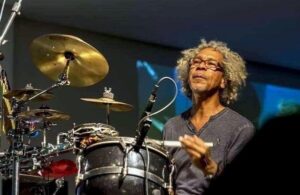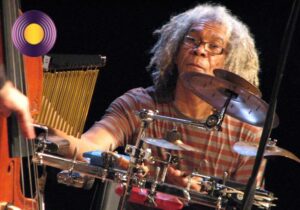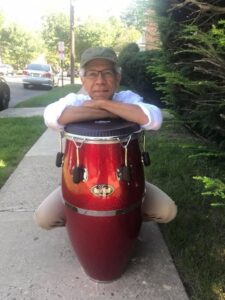Eusebio Enrique Iriarte, “Culebra Iriarte, was born on January 24, 1947 in Maiquetía, in the Republic of Venezuela.

In his childhood, Enrique Iriarte was already taking his first steps in the musical world with his father, who played several instruments.
His name was born in the Sonora Caracas thanks to the vocalist Johnny Perez when he discovered the thinness.
After his incursion in this world, with the inherited talent and the permanent updating and musical practice, has allowed him to treasure a long trajectory full of experiences next to orchestras such as La Sonora Caracas, Federico y su Combo Latino, El Sexteto Juventud, Don Filemón, in the beginnings of La Dimensión Latina for 10 months.
He also accompanied Oscar D’León on piano, for whom he also arranged his songs, among which are: “Mata Siguaraya”, “El Manicero”, “Siéntate Ahí”, “Mi Bajo y Yo”, “Mis Hijos”, “Juanita Morei”, “María”, “Ven Morena”, among many others.
In 1981 he recorded his first long-playing record, standing out with the song “La Ola Marina”, a piece that reached the first place in the music scene. It is worth mentioning that this album earned him a platinum record.
With more than six decades of artistic career, this Venezuelan virtuoso has left an indelible mark on salsa, collaborating with great artists such as Oscar D’León. During his career, the experience gained in iconic groups such as: La Dimensión Latina, Sonora Caracas, Federico y su Combo Latino, among others.
Currently, he continues to perform with his Sonora and has already become an internationally recognized musician.
Enrrique “CulebraIriarte Icon of Salsa is declared Illustrious Son of La Guaira and Cultural Heritage of Venezuela.
“Mr. Felo Bacallao Founder of the Aragon Orchestra, we are very proud to have as Cultural Heritage this distinguished MUSICIAN Maestro Enrique Culebra Iriarte”.
Reconocen trayectoria de “Culebra” Iriarte
September 28, 2019
The outstanding Guairean musician and arranger Enrique “Culebra” Iriarte was honored for his career, being considered one of the best salsa pianist, in an event held in the auditorium of the Bolivar Chavez Square.
Iriarte has stood out as a member of orchestras such as La Sonora Caracas, Federico y su Combo Latino, Sexteto Juventud and Don Filemón.
He was one of the founders of Dimensión Latina, the group that paid tribute to him yesterday and with whom he shared in some of the interpretations made by Rodrigo Mendoza, José and Edie Pacheco.
Culebra accompanied Oscar de Leon for many years as arranger of many of his songs.
The Mayor’s Office of Vargas presented him with the Armando Reverón order, within the framework of the municipal program “Forjadores y Forjadoras de Identidad Guaireña”, which seeks to exalt the work of men and women from Guaire.

“This is an emotional act with the presence of many musicians of the region, friends and relatives of Iriarte, to exalt the legacy that for years has given us this extraordinary musician. This is the twelfth award to people who have marked the local history”, said Alexis Rumbo, secretary of municipal government.
Percussionist Augusto Felibertt relates: exactly from 1997 to 1999 I was in the ranks of Maestro Enrrique ¨Culebra¨ Iriarte and his Sonora playing the Tumbadoras, at that time the founding members were:
Enrrique ¨Culebra¨ Iriarte: Pianist, Musical Director and Arranger, Eli: Bassist.
Juan Pablo Barrios: Timbalito, Campana and Bongo, Larry Machado: Singer, Perla Tabata: Singer, then Maritza De Quisquella, Cesar Pinto: 1st Trumpet, Yenny: 2nd, 3rd Trumpet a special guest, substitute percussionists: Yomar Mendez (Caballo) and Heyzer Cabrera.
Tremendous experience lived with all these musicians. Fabulous.
Note: The rehearsal studio at No 41 in Caño Amarillo-Caracas.

Cheo Navarro, Naty and El Maestro Enrique “Culebra” Iriarte Respected Masters and indisputable referents of the sound of Salsa and its history in Venezuela!!!!!
It has been for me immensely pleasing to share and receive with them this valuable recognition from SALSA SUPERIOR INTRNACIONAL!
Enrrique “Culebra” Iriarte, Alfredo “Guajeo” Naranjo, Dj. Augusto Felibertt, Elio Pacheco, Cheo “Bailatino” Navarro and Joseito Rodriguez 2nd Edition of the International Award 2022 by Richard Roman Director and Founder of Salsa Superior Miami.

Also Read: Eddie Palmieri brought salsa for the first time and live from Sing Sing Penitentiary in New York














